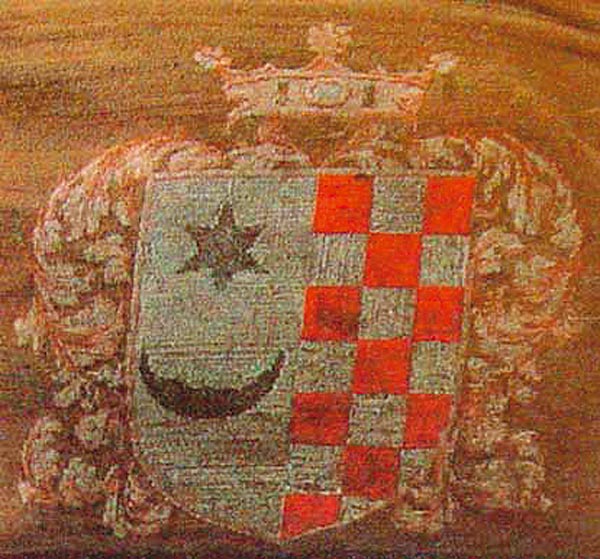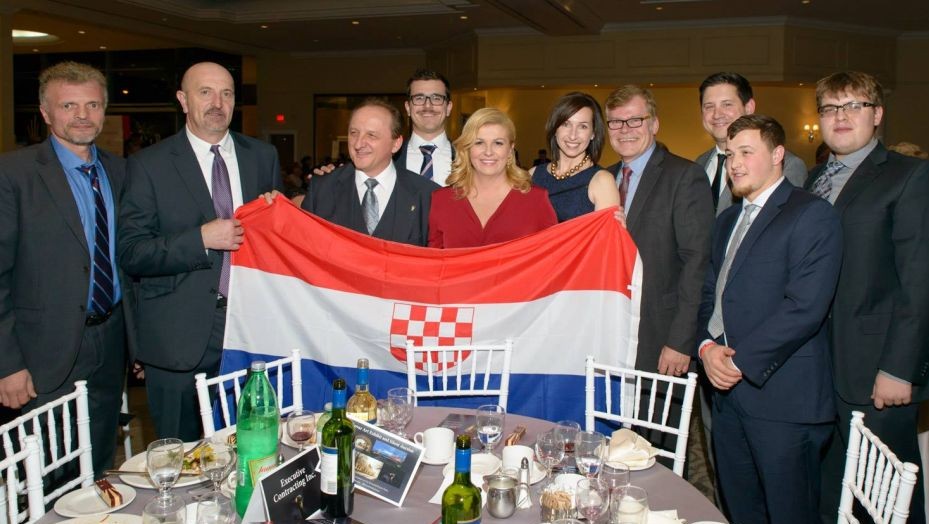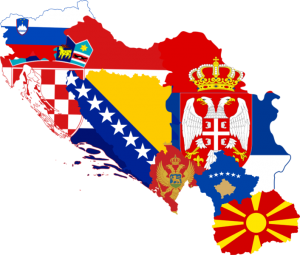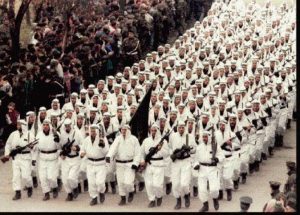
Views: 1084
 Top personalities of the Croatian Revival Movement
Top personalities of the Croatian Revival Movement
Preface
This text investigates the question of relations between the Croatian national revival movement and the Serbs from 1830 to 1847. Special investigation attention is put on the problem of how the language influenced ethnonational group identity among the Croats and Serbs in Dalmatia, Croatia and Slavonia (the so-called Triune Kingdom) during the period of the Croatian national revival movement that was officially and not only formally named as the Illyrian Movement. This investigation is an attempt to reconstruct the mainstream of the politics by the leaders of the movement and their outlines on how to solve both the Croatian and the South Slavic questions within South-East Europe and reactions by the Serbs to such politics.
In my opinion, previous research attempts in ex-Yugoslavia to deal properly with the problem of relations between the Illyrian Movement and the Serbs basically failed for different political and ideological reasons especially to investigate accurately a role of the language in the ideological structure of the movement as a model of the definition of the Croatian and Serbian ethnonationalities and subsequently as a model of the creation of a ethnolinguistically-defined national states of the South Slavs. The findings of the previous research largely misinterpreted the linguistic side of the political ideology of the movement, mainly suggesting that the Croatian political leadership fought for a pan-South Slavic cultural and even political (state) unification. However, my research hypothesis is based on the assumption that most probably the ultimate goal of the movement was to establish not “Yugoslavia” but rather a Greater Croatia and as such to politically reshape a map of the Balkan Peninsula and South-East Europe in the Croat ethnonational favor.
In the other words, the main attention in the former investigations has been to analyze the political structure of the ideological framework of the movement, while the structure and the importance of the linguistic model of the national determination and the creation of a united national state have been largely disregarded mainly for political reasons. In my strong opinion, the subject needs to be further investigated for at least two reasons:
- The previous research in the field was incomplete; it still remains unclear whether or not language played an important role within the ideological framework of the movement.
- The results of the previous researches are diametrically controversial: (a) within one approach, the ultimate political aim of the Movement was to establish a united South Slavic, basically Croato-Serbian, national state,[i] whereas (b) according to the other approach, the leaders of the movement struggled for an independent Triune Kingdom of Dalmatia, Croatia and Slavonia.[ii]
A majority of published academic works on the topic in the Yugoslav historiography after both WWI and WWII deal with the manifestation of extreme pan-South Slavic unity in a cultural-linguistic point of view. The ideology of the movement became used and misused for the practical-political purpose of the Serbo-Croat and Yugoslav brotherhood and unity within Yugoslavia.[iii] I have tried to reconstruct the opinions of influential members of the movement and their opponents about the problem of the South Slavic national identification and to complete the picture of their political works on resolving national question(s).[iv]
The origins of the Croatian national revival movement
The Croatian national revival movement (officially named as the Illyrian Movement) emerged with the name of the Croatian national worker and politician of the German origin[v], Ljudevit Gaj (1809−1872) in 1830 when he published in Buda(Pest) a brochure in two languages (the Croatian-kajkavian and the German) Kratka osnova horvatsko-slavenskoga pravopisanja/Die Kleine Kroatische-Slavischen Orthographie (Short Foundation of Croatian-Slavonic Orthography). This publication marked the beginning of the Croatian national revival movement, which is considered in the Croatian historiography as the period of the Croatian national renaissance. It can be said that from this period starts a modern Croatian history, but also and modern Croatian nationalism and history of political thoughts. The brochure Kratka osnova horvatsko-slavenskog pravopisanja became the foundation for both the further development of the policy of standardization of a literal-public language of the Croats and as well for reform of orthography among the Croats. Incontestably, Lj. Gaj in 1830 reformed the Croatian orthography and stressed the importance of the literal unity of the Croats with the other South Slavs, particularly with the Serbs who were speaking (only) štokavian dialect as a national language.
However, it is of the cardinal importance for a proper understanding of the movement from a political viewpoint that his orthography book of the “Croatian” language (as it is titled as such) from 1830 was written in kajkavian dialect but not in štokavian or čakavian. In other words, even de facto a founder of the movement considered at the very beginning of its development that a genuine Croat ethnonational language is kajkavian and only kajkavian! Further, it has to be stressed that Lj. Gaj’s orthographic modification of the Croatian writings was done fundamentally according to the pattern of the Czech orthography. This new Croatian orthography, which was accepted by the neighboring kajkavian Slovenes as well, became known as gajica.[vi]
In the same year (1830) a protonotar (secretary) of the Triune Kingdom, Josip Kušević (1775−1846), published in the Latin language one of the most important political works in the Croatian modern history: Iura municipalia… The book was dealing with the special political rights and constitution of the Triune Kingdom of Dalmatia, Croatia and Slavonia. The author, in fact, tried to refute the Hungarian claims that after the year of 1102 (when the Kingdom of Dalmatia, Croatia and Slavonia joined the Kingdom of Hungary by personal union in the personality of the Hungarian King Coloman [“the Book-Lover”] 1095–1116), Croatia, Dalmatia and Slavonia (three historical provinces of the Croats claimed as such by the Croatian historiography) became the ordinary province within a greater historical Hungary without any special political status, rights or autonomy. In other words, the Hungarian politicians and historians (correctly and lawfully) claimed that after the year of 1102 Croatia, Slavonia and Dalmatia lost any state or municipal rights and that historical lands of the Croats (claimed as such by the Croats) became partes subjectae (“subdued parts”) of Hungary as simply conquered by military means but not incorporated by the legal agreement.[vii] It means, furthermore, that the Hungarian language has to be the only mandatory public-official medium of communication within the whole Hungary including and the Triune Kingdom.
However, contrary to such Hungarian claims, J. Kušević argued that historical Croatian lands (Dalmatia, Slavonia, and Croatia) made a political (personal) union with the Kingdom of Hungary and that after 1102 Hungary and Croatia were regna socia (“united kingdoms”) with equal political rights.[viii] This J. Kušević’s program became the first formulation of the Croatian historical and state rights, which later in the 19th century became the foundation of the programs of several Croatian political parties[ix] usually of the ultra-right political-ideological orientation. Among them, the most important has been the Croatian Party of Rights, established in 1861[x] – the party that paved an ideological foundation of the Croat Nazi Ustashi movement from 1929 onwards and a policy of genocide committed on the Serbs in the Independent State of Croatia, 1941−1945.[xi] Nevertheless, it was not preserved any authentic Croatian-Hungarian contract from 1102 and all Croat claims on Pacta conventa are based on several 14th-century not fully reliable documents in which the term “contract” is just mentioned.[xii] But the Croat interpretation of the 1102 Question put on the paper by Josip Kušević in 1830 became later the foundation for the Croat state-national nationalism and even imperialism based on the so-called Thousand years of the Croat state–historic rights theory.[xiii]
The next step in the development of the Croatian national revival was made by Ivan Derkos when he published in 1832 in the Latin language in Zagreb (Zágráb/Agram) Genius patriae super dormientibus sius filiis (The genius of the motherland above its sleeping sons). I. Derkos with this book tried to wake up the love towards the motherland among the Croats, but in addition and to promote an idea of a single Croatian literal language that has to be composed by a combination of the three South Slavic dialects: kajkavian (spoken by the Croats in North-West Croatia and the Slovenes in Slovenia), čakavian (spoken by the Croats in North Dalmatia, Istria and Dalmatian islands) and štokavian (spoken by all Serbs and very small number of those who accepted the ethnic name of the Croats at that time).[xiv] However, I. Derkos was in the opinion that all of these three South Slavic dialects were spoken solely by the Croats, i.e. that the Croatian language consists kajkavian, čakavian and štokavian dialects what was from that time perspective simply out of the truth as the genuine ethnic Croats did not speak the štokavian dialect. Nevertheless, this I. Derkos’ claim became from the mid-19th century the key backbone within a framework of the Croatian linguistic nationalism and territorial imperialism at the expense of the (Serb)-štokavian populated territories, i.e., on the territories inhabited by the Roman Catholic speakers of the ijekavian sub-dialect of the štokavian dialect.[xv] As an immediate consequence, it provoked in due course a harsh Serbian reaction and finally alienated the Serbs (and the Slovenes) from the Croatian Illyrian ideology of Yugoslavism.[xvi] The crux of the matter is that the legacy of such I. Derkos’ linguistic-philological policy had a far-reaching effect up to the present days: an official Croat philology started to claim from the time of the Illyrian Movement that historically the ethnonational language of the Croats was and is composed by three dialects – čakavian, kajkavian, and štokavian.[xvii]
In the same year of printing of I. Derkos’ work, a Croatian count Janko Drašković (1770−1856) published in Karlovac Disertatia iliti razgovor darovan gospodi poklisárom zakonskim y buduchjem zakonotvorzem kraljevinah nasih za buduchu Dietu Ungarsku odaslanem (Dissertation or Talk…) which was the first Croatian national political program book written in the štokavian dialect (but not according to the new Lj. Gaj’s orthography).[xviii] This work was actually the political program of both the Croatian national revival movement and the Croatian nation in which the author required the political, economic, linguistic and cultural union of all “Croatian” lands into one single national state of ethnolinguistic Croats. In such a way, a “united Croatia”, or better to say – a Greater Croatia was named by J. Drašković as a Greater Illyria. The lands which should be incorporated into his united Croatia were the following: Croatia, Slavonia, Rijeka/Fiume, the Military Border, Bosnia, Herzegovina, Montenegro, Dalmatia, and the Slovenian provinces (Kranjska). According to him, a united (Greater) Croatia would stay in political union with the Kingdom of Hungary, but both Hungary and united Croatia would remain as the parts of the Habsburg Monarchy which has to give financial, political, and other support for the realization of such megalomaniac nationalistic political program. In such a united-Greater Croatia the official language would be the Illyrian, i.e. according to J. Drašković, the “Croatian” language of the štokavian dialect, while the supreme authority would be in the hands of the Ban (the Governor or prorex). Finally, at the same time, he required a modification of the Croatian feudal system and development of the Croatian trade and economy.
Nevertheless, J. Drašković’s 1832 political program of a Greater Croatia has at least four far-reaching consequences for the region of South-East Europe:
- It finally paved a road to the creation of a modern framework of a Greater Croatia founded on both alleged Croatia’s state-political and Croat ethnolinguistic rights.
- It gave a crucial impetus to the Croat nationalists to claim all the South Slavic populated lands by the štokavian speakers as exclusively Croats.
- It became the foundation for the later Croat political requirements to transform the Habsburg Monarchy into a trialist federation composed by Austria, Hungary, and Croatia.
- It was the basis for a Croat appropriation of the Illyrian name (a historic ethnonym for the South Slavs or just for the Serbs) as a synonym for the Croat ethnolinguistic nation.[xix]
Undeniably, above-mentioned writers have to be considered as the founders of the Croat-called Illyrian Movement that lasted until 1847 when according to the Croatian historiography:
- The national language of the Croats achieved a final victory over the Germanization and the Magyarization processes in Croatia and Slavonia.
- The Illyrian name (as the common name for all South Slavs) was replaced with the national name of the Croats.[xx]
In spite of this (Croat) explanation, it can be argued that the Illyrian Movement, as a synonym for the most important period of the Croat national renaissance, ended in 1847 when the crucial far-reaching Croat political plans and national claims shaped in 1830 by the founders of the movement became officially recognized by the Austrian/Habsburg authorities:
- The (Serb ethnonational) štokavian dialect (language) was recognized as one of the three national dialects of the Croats and as only official Croat standardized dialect in public use. Therefore, the Croats could claim all cultural inheritance written in the štokavian dialect as a common Serbo-Croat (the Yugoslav, etc.) end later on even to demand that such štokavian-language inheritance has to be recognized as exclusively ethnic Croat one.
- All South Slavs (the Illyrians) are recognized by Vienna as ethnolinguistic Croats and subsequently, all South Slavic (the Yugoslav) territories within the Austrian (Habsburg) Monarchy (from 1867 Austria-Hungary) can be included into a Greater Croatia as a national administrative unit of the Croats in the monarchy.
In the larger sense of periodization, a whole Croatian national revival (renaissance) movement can be subdivided into the following periods:
- The period of the preparatory time from the end of the 18th century to 1829.
- The first (early) period from 1830 to 1834.
- The developed period from 1835 to 1842.
- The period of the prohibition of the Illyrian name (1843–1845).
- The period of a replacement of the Illyrian name by the national name of the Croats (1846–1874).[xxi]
www.global-politics.eu/sotirovic
sotirovic@global-politics.eu
© Vladislav B. Sotirović 2019
[i] For instance, see [I. Božić, S. Ćirković, M. Ekmečić, V. Dedijer, Istorija Jugoslavije, Beograd: Prosveta, 1973, 238−242].
[ii] For instance, see [D. Pavličević, Povijest Hrvatske. Drugo, izmijenjeno i prošireno izdanje, Zagreb: Naklada P.I.P. Pavičić, 2000, 252].
[iii] For instance, see [B. Petranović, Istorija Jugoslavije 1918−1988, Prva knjiga: Kraljevina Jugoslavija 1914−1941, Beograd: Nolit, 1988, 3].
[iv] On the pre-modern identity in Croatia, Dalmatia and Slavonia, see [J. Fine, When Ethnicity Did Not Matter in the Balkans: A Study of Identity in Pre-Nationalist Croatia, Dalmatia, and Slavonia in the Medieval and Early Modern Periods, University of Michigan Press, 2006].
[v] His father, Johan Gay, was a German physician who came to live in North Croatia (in Krapina) in 1786. Lj. Gaj’s ancestors from the father’s side were from Burgundy and Slovakia. Lj. Gaj’s mother was Juliana Schmidt. Lj. Gaj’s mother tongue was a German [I. Perić, Povijest Hrvata, Zagreb: Krinen, 1997, 151].
[vi] D. Pavličević, Povijest Hrvatske. Drugo, izmijenjeno i prošireno izdanje, Zagreb: Naklada P.I.P. Pavičić, 2000, 244. On more profound account on Lj. Gaj’s role in the movement, see [E. M. Despelatović, Ljudevit Gaj and the Illyrian Movement, New York−London: University of Michigan, East European Monographs, 1975; N. Stančić, Ideologija Ljudevita Gaja u pripremnom razdoblju hrvatskog narodnog preporoda, Zagreb, 1989].
[vii] For instance, see [L. Kontler, Millenium in Central Europe: A History of Hungary, Budapest: Atlantisz Publishing House, 1999, 63−65; П. Рокаи, З. Ђере, Т. Пал, А. Касаш, Историја Мађара, Београд: Clio, 2002, 44].
[viii] For the matter of comparison, a conflict between the Croatian and the Hungarian aristocracy over the “state-historical rights” of Dalmatia, Croatia and Slavonia in the Kingdom of Hungary after 1102 up to the end of the Habsburg Monarchy and Austria-Hungary in 1918 is very similar to the conflict between the Polish and the Lithuanian aristocracy over the state-political position of the Grand Duchy of Lithuania within the Kingdom of Poland after the Krėva Union act of 1385 and in the Republic of Two Nations, i.e. the Polish-Lithuanian Commonwealth after the Lublin Union act signed on July 1st, 1569 (Rzeczpospolita Obojga Narodow). While the Polish authorities and scholars claimed that Lithuania legally lost her statehood after both signed acts with Poland in 1385 and especially in 1569 and became an ordinary province of the Kingdom of Poland without any special state-political rights, the Lithuanian aristocracy claimed that the Lublin Union was a confederation act of two independent states in which the Grand Duchy of Lithuania preserved, in essence, her statehood. About this problem, see more in [N. Davies, God’s Playground: A History of Poland, vol. I, The Origins to 1795, New York: Columbia University Press, 1982; R. L. Johnson, Central Europe: Enemies, Neighbors, Friends, New York−Oxford, 1996, 105–136; P. S. Wandicz, Laisvės kaina: Vidurio Rytų Europos istorija nuo viduramžių iki dabarties, Vilnius, 1997, 127–138; R. Bideleux, I. Jeffries, A History of Eastern Europe: Crisis and Change, London−New York: Routledge, 1998, 114–164; E. Gudavičius, Lietuvos istorija nuo seniausių laikų iki 1569 metų, Vilnius: Lietuvos rašytijų sąjungos leidykla, 1999, 161−165, 634−645; Z. Kiaupa, J. Kiaupienė, A. Kuncevičus, The History of Lithuania before 1795, Vilnius: Lithuanian Institute of History, 2000, 282–304; S. Cynarski, “The Shape of Sarmatian Ideology in Poland”, Acta Poloniae Historica, 19, 6–17; A. Bumblauskas, Lietuvos istorija 1009−1795, Vilnius: R. Paknio leidykla, 2007, 120−121, 288−293; Z. Zinkevičius, Lietuviai: Praeities, didybė ir sunykimas, Vilnius: Mokslo ir enciklopedijų leidybos centras, 2013, 174−179]. It became a common attitude of modern Western historians of non-Polish ethnic origin to describe the Republic of Two Nations as exclusively a Polish one due to the high level of linguistic Polonization of the Lithuanian society and culture. See, for instance [A. Palmer, The Lands Between: A History of East-Central Europe since the Congress of Vienna, London, 1970, 4]. The fact is that majority of the Polish scholars and other Polish writers from the legal point of view, rightfully claim that the Grand Duchy of Lithuania became an integral part of the Kingdom of Poland even before the Lublin Union, i.e. after the Union of the Act of Krėva/Krewo (August 14th, 1385). See, for instance [J. Vislicius, Bellum Prutenum, 1515; M. Kromer, De origine et rebus gestis Polonarum, Basel, 1555]. However, the majority of their Lithuanian colleagues claim that the Grand Duchy of Lithuania did not lose its state-political sovereignty either after 1385 or 1569 unions with Poland [E. Bakonis et al., Lietuvos istorija: Ilustruota enciklopedija, Vilnius: Šviesa, 2012, 84−86].
[ix] J. Kušević, De municipalibus iuribus et statutis Regnorum Dalmatiae, Croatiae et Slavoniae, Zagreb, 1830.
[x] M. Gross, Povijest pravaške ideologije, Zagreb, 1973; A. Starčević, Izabrani politički spisi, Zagreb, 1999; D. Pavličević, Povijest Hrvatske. Drugo, izmijenjeno i prošireno izdanje, Zagreb: Naklada P.I.P. Pavičić, 2000, 245.
[xi] For a deeper account of this issue, see [В. Ђ. Крестић, Геноцидом до велике Хрватске. Друго допуњено издање, Јагодина: Гамбит, 2002]. A leader (poglavnik) of the Ustashi movement and a head of the Independent State of Croatia during WWII, Ante Pavelić, was in his youth a member of the Pure Croatian Party of Rights lead by the Croat ultra-nationalist and Serbophobic Josip Frank of the Jewish origin [B. J. Fišer, Balkanski diktatori: Diktatori i autoritarni vladari jugoistočne Evrope, Beograd: IPS Media−IP Prosveta, 2009, 232].
[xii] П. Рокаи, З. Ђере, Т. Пал, А. Касаш, Историја Мађара, Београд: Clio, 2002, 44.
[xiii] Probably as the best example of such claims is [S. Srkulj, J. Lučić, Hrvatska povijest u dvadeset pet karata. Prošireno i dopunjeno izdanje, Zagreb: Hrvatski informativni centar, 1996]. According to many Serb scholars, this theory was and is the main cause of interethnic conflicts between the Croats and the Serbs in Dalmatia, Croatia, Bosnia, Herzegovina, Srem, and Slavonia [В. Ђ. Крестић, Геноцидом до велике Хрватске. Друго допуњено издање, Јагодина: Гамбит, 2002, 23−62].
[xiv] П. Милосављевић, Срби и њихов језик: Хрестоматија, Приштина: Народна и универзитетска библиотека, 1997, 13–50.
[xv] On the question of disputed territories between the Croats and the Serbs, see [Л. М. Костић, Спорне територије Срба и Хрвата, Београд: Дерета, 1990].
[xvi] About the issue of the Croatian and the Serbian linguistic nationalism in the first half of the 19th century, see: [V. B. Sotirović, Srpski komonvelt: Lingvistički model definisanja srpske nacije Vuka Stefanovića Karadžića i projekat Ilije Garašanina o stvaranju lingvistički određene države Srba, Vilnius: privatno izdanje, 2011; V. B. Sotirović, “Nacionalno samoodređenje Hrvata i Srba putem jezika u Trojednoj Kraljevini Dalmaciji, Hrvatskoj i Slavoniji, 1835.–1848. g.”, Zgodovinski časopis/Historical Review, Ljubljana, letnik 58, 3–4 (130), 2004, 377–389].
[xvii] For instance, see [M. Moguš, Povijest hrvatskoga književnoga jezika, Zagreb: Nakladni zavod Globus, 1993; M. Kačić, Hrvatski i srpski: Zablude i krivotvorine, Zagreb: Zavod za lingvistiku Filozofskog fakulteta Sveučilišta u Zagrebu, 1995; M. Lončarić, Hrvatski jezik, Opole: Uniwersytet Opolski–Instytut Filologii Polskiej, 1998].
[xviii] A German-language edition of the book was published in Zagreb (Agram) in 1834.
[xix] A Croatian historian Josip Horvat was in the opinion that J. Drašković’s program of a Greater Illyria was, in essence, the “Austro-Slavic” concept of federalization of the Austrian Empire (former Habsburg Monarchy). However, I would call such a project as the “Austro-Croat” rather than the “Austro-Slavic” or the “Austro-Yugoslav”.
[xx] For instance, see [J. Šidak et al., Hrvatski narodni preporod-Ilirski pokret, Drugo izdanje, Zagreb, 1990].
[xxi] J. Šidak et al., Hrvatski narodni preporod, I, Zagreb, 1965, 7.
 Croatian President Kolinda Grabar-Kitarovic with Croat Nazi WWII flag
Croatian President Kolinda Grabar-Kitarovic with Croat Nazi WWII flag









